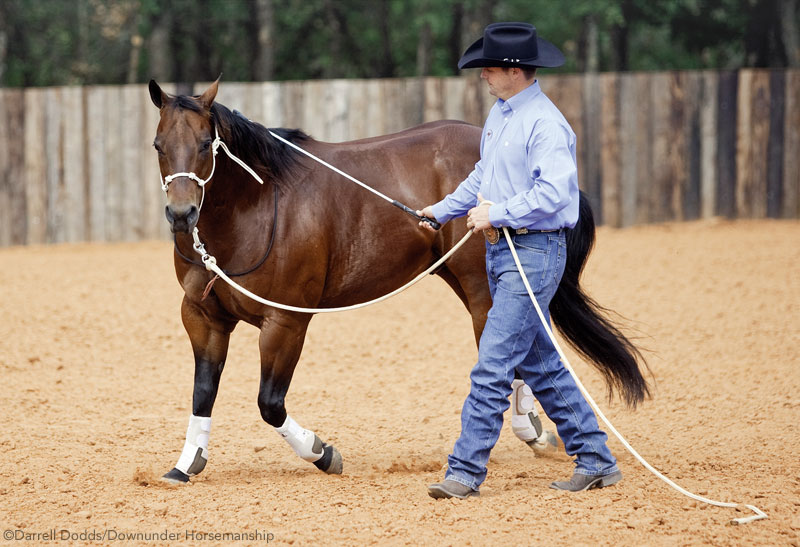
The goal of this exercise is to get the horse to trot around beside you in a circle, staying 4 feet away while remaining relaxed, maintaining an arc in his body and keeping slack in the lead rope both in the circle and during changes of direction.
Step 1
Get started by standing next to your horse as if you were going to lead him. Hold the lead rope in your left hand, about 4 feet down from the clip, so that your knuckles are on top of the rope. Keep your training stick in your inside hand and rest it on top of the horse’s withers.
Step 2
Look straight ahead and take three steps forward.
Step 3
As you walk forward, point up high straight in front of you with your left hand to show the horse the direction you want him to go. If the horse doesn’t trot forward off the pressure from the point of your hand, tap him with the stick as far back on his body as you can reach until he trots up beside you.
Step 4
As soon as the horse comes up beside you, start walking a small circle to the left. Your belly button should be facing forward and around so that your body is twisted slightly away from the horse. If you face the horse with your belly button, you’ll unintentionally drive him away from you.
Step 5
Glue your left hand, holding the lead rope, to your belly button and keep the training stick on the horse’s withers.
|
Step 6
Anytime you see more than 3 inches of the stick on the other side of the horse’s spine, it means he’s too close to you. Use the stick to tap him away on the side of his neck. Start gently and gradually increase the pressure until he moves away.
Step 7
To change direction, yield the horse’s hindquarters by turning your belly button 90 degrees toward his hindquarters. Then take one big step toward his tail, swinging the stick toward his hindquarters at the same time. As soon as the horse yields, freeze (do not turn to face the horse). If done correctly, the horse should be staring directly at your left shoulder.
Step 8
Switch the tools in your hands. Pass the stick underneath the lead rope to your left hand and grab ahold of the lead rope in your right hand. Then look up. Take three steps forward, keeping your eyes focused straight ahead.
Step 9
Once you’ve taken three steps forward, point up high in the air directly in front of you with your right hand, asking the horse to come up beside you. If the horse doesn’t immediately trot up beside you when you raise your hand and signal him to move forward, start tapping him with your training stick.
Step 10
When you and your horse are proficient at changing direction, you can refine the exercise by continually moving your feet when you ask the horse to change direction. That means that you’ll yield the horse’s hindquarters, look up and continue walking a straight line as you change hands, point, and if necessary tap with the stick. Once the horse is beside you, you’ll head off in a new circle. When done correctly, it should look like you’re dancing, with each step flowing smoothly together.
More from Clinton Anderson:
Ask the Expert: Runaway Trail Horse
Video: Backing for Respect
This article originally appeared in the February 2015 issue of Horse Illustrated magazine. Click here to subscribe!






good advice
I will give this a try.
cool
Going down the indoor in a little while and try this with both my horses. Neither is pushy at all, but it’s a great thing for me to teach them during this cold snap when it’s too cold to even ride inside!
I did go and do it, only I probably should have lunged them first. A little full of themselves and wanted to lope rather than jog! Also my mare, who is a showmanship queen, thought that when I turned to the right she was do either back up or do a 360 pivot. My gelding was much softer, he’s been free lunged in a round pen and knows body language, he was a charm to do it with.
Lol!,omg! I’m having the worst time with this! My mare is pushing and dull and lazy, I’ve gone back and done the sending exercise to make sure she’s light on the halter, which helps her come forward, but than she goes too fast and will stay away from me but eventually push right up against me, and I wack and wack and she will not move away! I end up stopping, back her off me and try again,same thing happens, so I’m taking a few days off and will just keep trying, and yes I build the pressure on her neck to get her away and had to really wack her just to come up beside me. Lololol. Dang horses